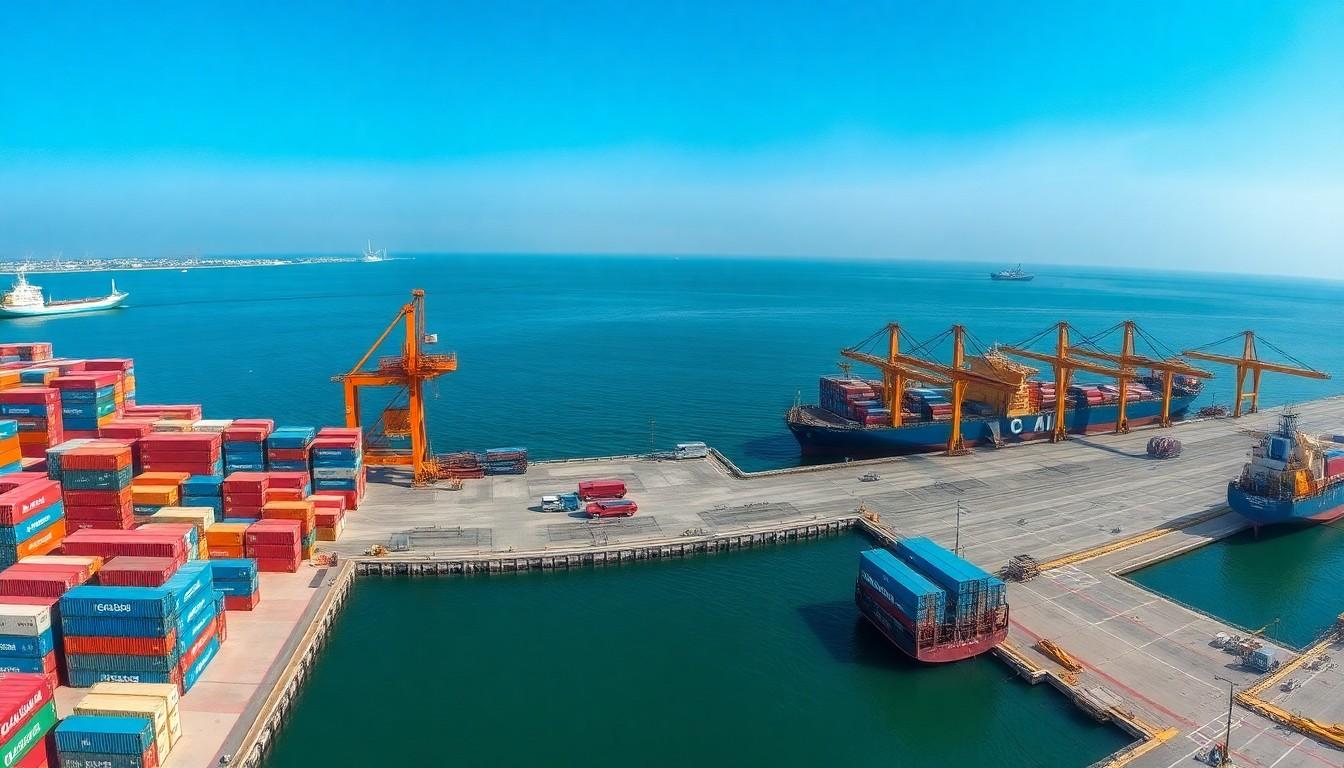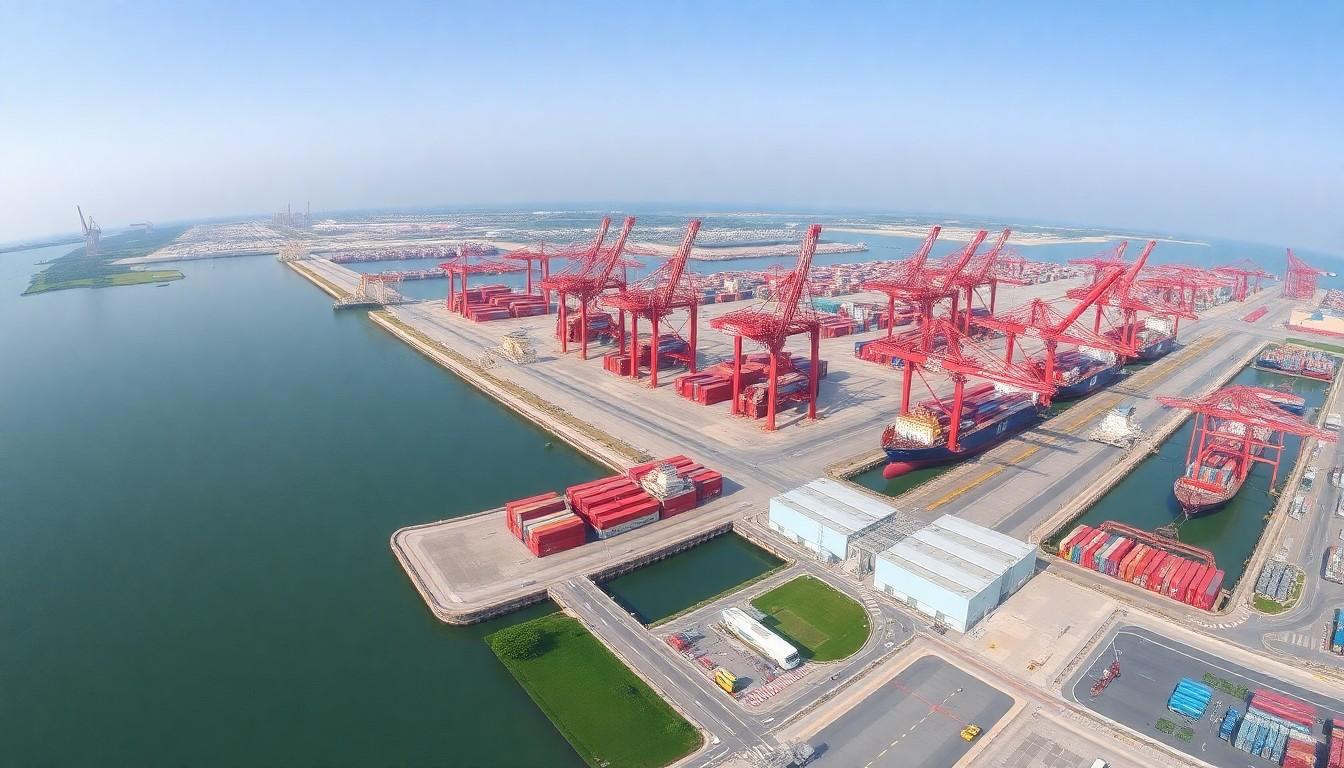Located along the bustling western coast of India, Quljamat Likavav Port Ltd stands as a testament to modern maritime innovation. This state-of-the-art port facility has transformed the region’s shipping landscape since its establishment, handling millions of tons of cargo annually while setting new benchmarks in operational efficiency.
What sets Quljamat Likavav apart isn’t just its impressive infrastructure – it’s the seamless blend of cutting-edge technology and environmental consciousness. The port’s strategic location and deep-draft capabilities make it a preferred choice for international vessels, while its automated systems and green initiatives have earned it recognition as one of India’s most progressive maritime facilities.
Quljamat Likavav Port Ltd
Quljamat Likavav Port Ltd operates across 2,500 hectares on India’s western coastline, featuring 12 deep-draft berths capable of handling vessels up to 200,000 DWT. The port processes 85 million tonnes of cargo annually through its multi-purpose terminals, specializing in bulk materials, containers, liquified natural gas.
The port’s infrastructure includes:
- Advanced cargo handling equipment with 25 post-Panamax cranes
- Automated container tracking systems covering 95% of operations
- 150,000 square meters of covered storage facilities
- Dedicated rail connectivity linking to 3 major industrial corridors
Key operational metrics demonstrate the port’s efficiency:
| Metric | Performance |
|---|---|
| Average vessel turnaround time | 24 hours |
| Container handling capacity | 4 million TEUs |
| Railway cargo share | 35% |
| Berth occupancy rate | 72% |
The port incorporates sustainable practices into its operations:
- Solar power generation facilities producing 8.5 MW
- Rainwater harvesting systems capturing 12 million liters annually
- Zero-waste discharge protocols
- Electric rubber-tired gantry cranes reducing emissions by 45%
Quljamat Likavav maintains strategic partnerships with 15 international shipping lines connecting to 75 ports globally. The facility employs 3,500 personnel operating in three shifts to ensure 24/7 operations. Modern security systems including RFID tracking cameras radar surveillance protect the premises through integrated command control centers.
History and Development

Quljamat Likavav Port Ltd emerged as a transformative maritime infrastructure project on India’s western coastline. The port’s evolution from conception to operational excellence spans three decades of strategic planning and phased development.
Early Establishment
Quljamat Likavav Port’s foundation began in 1994 through a public-private partnership initiative. The Gujarat Maritime Board selected the natural deep-water site after extensive geological surveys revealed ideal conditions for a modern port facility. Construction commenced in 1997 with an initial investment of $450 million focused on developing basic infrastructure including the breakwater barrier dock wall. The first phase included creating two multi-purpose berths a container terminal with 14-meter draft capacity.
Major Milestones
| Year | Achievement | Impact |
|---|---|---|
| 1999 | First Terminal | 500,000 TEUs |
| 2003 | Berth Expansion | 25M tonnes |
| 2015 | LNG Terminal | 5M tonnes |
| 2022 | Digital System | 100% paperless |
Port Infrastructure and Facilities
Quljamat Likavav Port Ltd maintains advanced infrastructure across its 2,500-hectare facility. The port’s modern equipment combines efficiency with environmental sustainability to handle diverse cargo operations.
Cargo Handling Capabilities
The port operates specialized equipment for distinct cargo types across 12 deep-draft berths. Five ship-to-shore gantry cranes process 35 container moves per hour while eight mobile harbor cranes handle bulk materials at 1,000 tonnes per hour. Advanced roll-on/roll-off ramps accommodate 200 vehicles simultaneously through two dedicated berths. The liquid cargo terminal features six loading arms with a throughput capacity of 2,000 cubic meters per hour. Automated guided vehicles transport containers between vessels and storage yards using AI-powered routing systems for optimal efficiency.
Storage Facilities
The port features 125,000 square meters of covered warehouse space with temperature-controlled zones for perishable goods. Open storage yards span 850,000 square meters with dedicated areas for containers automobiles bulk cargo chemical tanks. Six cold storage units maintain temperatures between -25°C to +15°C across 15,000 square meters. Custom bonded warehouses provide 35,000 square meters for import-export cargo. The container freight station processes 500 TEUs daily through its 75,000-square-meter facility equipped with automated inventory management systems.
Operations and Services
Quljamat Likavav Port Ltd delivers comprehensive maritime services through its integrated terminal operations. The port’s strategic location enables efficient cargo handling across multiple trade routes while maintaining strong partnerships with global shipping companies.
Shipping Routes
Quljamat Likavav Port maintains active connections with 45 major ports across Asia Pacific Europe America. Its primary routes include weekly services to Singapore Dubai Rotterdam Shanghai Los Angeles. The port operates dedicated feeder services connecting 12 regional ports in the Arabian Sea Bay of Bengal. Express routes facilitate 72-hour transit times to Middle Eastern ports 96-hour connections to Southeast Asian hubs. Container vessels follow fixed-day weekly schedules on 8 international routes with 95% on-time performance.
Trade Partners
The port collaborates with 75 international trading companies across 25 countries. Major partnerships include agreements with European automobile manufacturers Korean electronics firms Japanese steel producers. The port processes cargo for 35 Fortune 500 companies maintaining dedicated facilities for their operations. Trading relationships span diverse sectors including petrochemicals agricultural products manufactured goods. Top import partners contribute 65% of total cargo volume originating from China South Korea Saudi Arabia. Export relationships focus on automotive parts chemicals textiles with primary destinations in Europe Southeast Asia North America.
Economic Impact
Quljamat Likavav Port Ltd drives substantial economic growth in western India through its maritime operations. The port’s presence catalyzes regional development while creating significant employment opportunities across multiple sectors.
Regional Development
The port spurs industrial growth across a 50-kilometer radius, attracting 85 manufacturing units that benefit from direct port connectivity. Its strategic location has transformed the surrounding region into a thriving economic zone, featuring 3 special economic zones focused on electronics manufacturing, petrochemicals processing, and automotive components. The port infrastructure supports 12 industrial parks, contributing $2.5 billion annually to the regional GDP. Local businesses experience 40% increased trade efficiency through reduced transportation costs and improved market access. The development includes upgraded road networks spanning 225 kilometers and railway infrastructure connecting 15 inland container depots.
Employment Generation
Quljamat Likavav Port Ltd creates 3,500 direct jobs through port operations and 12,000 indirect employment opportunities in associated services. The port’s presence generates positions across cargo handling, logistics, maritime services, warehousing, and technology management sectors. Maritime training programs at the port facility qualify 500 professionals annually for specialized roles. Local communities benefit from 75% employment preference in port-related activities. The port’s expansion activities support 2,500 construction jobs during project phases. Technical partnerships with 25 educational institutions create skilled workforce pathways through internships and placement programs.
Future Expansion Plans
Quljamat Likavav Port Ltd implements a $750 million expansion project scheduled for completion by 2027. Phase one includes constructing three additional deep-draft berths capable of handling vessels up to 250,000 DWT. The expansion adds 1,200 hectares of operational area featuring automated cargo handling systems.
Key infrastructure developments encompass:
- Installing 8 new ship-to-shore gantry cranes with 45 moves per hour capacity
- Creating 200,000 square meters of climate-controlled warehouse space
- Developing an integrated multimodal logistics park spanning 350 hectares
- Building a dedicated automotive terminal processing 250,000 units annually
Technological upgrades focus on:
- Implementing blockchain-based cargo tracking systems
- Deploying 25 autonomous guided vehicles for container movement
- Integrating 5G connectivity across port operations
- Installing smart sensors for real-time equipment monitoring
Environmental initiatives include:
- Establishing a 50-megawatt solar power plant
- Installing wind turbines generating 25 megawatts of power
- Creating marine ecosystem protection zones spanning 100 hectares
- Developing water recycling systems processing 5 million liters daily
| Expansion Metrics | Current | Target 2027 |
|---|---|---|
| Annual Capacity | 85 MT | 150 MT |
| Container Volume | 4M TEUs | 7M TEUs |
| Direct Employment | 3,500 | 5,800 |
| Berth Count | 12 | 15 |
Strategic partnerships strengthen these developments through collaborations with international port operators from Singapore Japan South Korea. Digital transformation initiatives connect the port with 65 global maritime facilities through an integrated port community system optimizing vessel scheduling cargo tracking customs clearance.
Comprehensive
Quljamat Likavav Port Ltd stands as a testament to India’s maritime excellence through its cutting-edge infrastructure state-of-the-art technology and unwavering commitment to sustainability. Its strategic location advanced facilities and efficient operations have positioned it as a crucial hub in global trade networks.
The port’s impressive metrics outstanding partnerships and comprehensive expansion plans reflect its dedication to continuous improvement and innovation. As it moves forward with its ambitious growth strategy Quljamat Likavav Port Ltd isn’t just shaping the future of maritime commerce – it’s driving substantial economic growth throughout western India.
The facility’s remarkable journey from its establishment to its current status as a world-class port demonstrates how strategic planning operational excellence and environmental responsibility can create lasting impact in the maritime sector.

